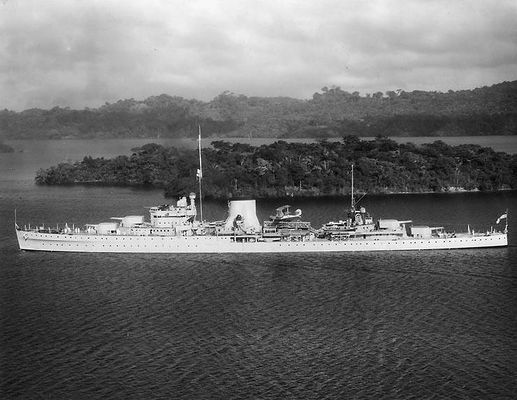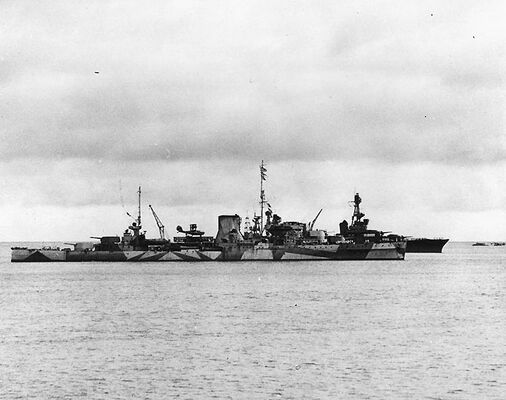Difference between revisions of "User:SirDixie:eu/sandbox"
| Revision as of 20:34, 19 January 2025 | Latest revision as of 16:38, 25 January 2025 | |||
| Line 52: | Line 52: | |||
| In January 1929, design work began on new light cruisers for the Royal Navy, the previous ''[[Emerald]]'' class being 3 years old by that time. The preliminary designs included aspects such as single mount 6-inch (152mm) guns, single mount 5.5-inch (140mm) guns, 6-inch guns in two-gun turrets, a catapult, and a single large funnel amidships. These preliminary designs displaced around 6,000 tons, however the design that was entered into the 1929 building program (called the Type "O" cruiser) displaced 6,500 tons, using many aspects that would become part of the ''Leander'' class. | In January 1929, design work began on new light cruisers for the Royal Navy, the previous ''[[Emerald]]'' class being 3 years old by that time. The preliminary designs included aspects such as single mount 6-inch (152mm) guns, single mount 5.5-inch (140mm) guns, 6-inch guns in two-gun turrets, a catapult, and a single large funnel amidships. These preliminary designs displaced around 6,000 tons, however the design that was entered into the 1929 building program (called the Type "O" cruiser) displaced 6,500 tons, using many aspects that would become part of the ''Leander'' class. | |||
| ? | The armament of the ''Leander'' class consisted of Eight new 6-inch /50 caliber Mk. XXIII guns, mounted in four two-gun turrets, in 'A', 'B', 'X' and 'Y' positions. An experimental twin turret was installed upon the ''Emerald''-class cruiser ''Enterprise'', which proved to be very successful, and influenced the design of the Mk.XXI turret used on ''Leander''. The secondary armament as built consisted of four single 4-inch (102mm) QF Mk.V guns, capable of dual purpose work. However, like most Royal Navy cruisers of this generation, these were subsequently replaced before the second world war by the more effective Mk.XIX twin mounting using the 4-inch QF Mk.XVI guns. However, ''Achilles'' | + | The armament of the ''Leander'' class consisted of Eight new 6-inch /50 caliber Mk. XXIII guns, mounted in four two-gun turrets, in 'A', 'B', 'X' and 'Y' positions. An experimental twin turret was installed upon the ''Emerald''-class cruiser ''Enterprise'', which proved to be very successful, and influenced the design of the Mk.XXI turret used on ''Leander''. The secondary armament as built consisted of four single 4-inch (102mm) QF Mk.V guns, capable of dual purpose work. However, like most Royal Navy cruisers of this generation, these were subsequently replaced before the second world war by the more effective Mk.XIX twin mounting using the 4-inch QF Mk.XVI guns. However, ''Achilles'' did not receive the new mounts until 1943. Though some preliminary designs had used two triple torpedo tubes per side, the ''Leander''s used two quadruple torpedo tubes per side instead. An aircraft catapult was also mounted amidships behind the single funnel. | |
| The original anti-aircraft armament was the 4-inch secondary guns, and 3 quadruple mount 12.7mm (0.5-inch) Vickers Machine gun mounts, however during World War 2, the anti-aircraft suite was upgraded substantially, with the addition of quadruple 40mm 'pompom' mounts and single 20mm 'Oerlikon' mounts. Later on, quadruple 40mm 'Bofors' were fitted to ''Ajax'' and ''Leander'', and twin 20mm 'Oerlikon' mounts were used. The aircraft catapult was also removed when allowed to make space for extra guns. On ''Leander'' and ''Achilles'', the 'X' turret was removed late in the war for more guns. | The original anti-aircraft armament was the 4-inch secondary guns, and 3 quadruple mount 12.7mm (0.5-inch) Vickers Machine gun mounts, however during World War 2, the anti-aircraft suite was upgraded substantially, with the addition of quadruple 40mm 'pompom' mounts and single 20mm 'Oerlikon' mounts. Later on, quadruple 40mm 'Bofors' were fitted to ''Ajax'' and ''Leander'', and twin 20mm 'Oerlikon' mounts were used. The aircraft catapult was also removed when allowed to make space for extra guns. On ''Leander'' and ''Achilles'', the 'X' turret was removed late in the war for more guns. | |||
Latest revision as of 16:38, 25 January 2025
Contents
HMS Leander, 1933
Construction
- Builder: Devonport Dockyard; Plymouth,
England, United Kingdom - Laid down: 8 September 1930
- Launched: 24 September 1931
- Commissioned: 24 March 1933
Specifications
- 7,270 tons displacement, standard
- 9,280 tons displacement, full load
- 169m length
- 16.76m beam
- 5.79m draft
Machinery
- Six (6) Admiralty three-drum boilers
- Four (4) Parsons steam turbines
Performance
- 32.5 knots at 72,000 shaft horsepower
- 5,730nm at 13 knots
Armor
- Main belt: 76.2mm (+25mm backing plate)
- Magazine Box: 88.9- 25.4mm
- Decks: 25.4mm, 31.75mm over machinery space
- Bulkheads : 38.1mm
- Turrets: 25.4mm
Armament
Main
- Eight (4x2) 152mm BL Mk.XXXIII guns
Secondary
- Four (4x1) 102mm QF Mk.V guns
Anti-Aircraft
- Twelve (3x4) 12.7mm MG Mk.III guns
Torpedoes
- Eight (2x4) 533mm torpedo tubes
Aircraft
- One E-II-H Catapult
- Two Aircraft (Fairey Seal, Fairey III, Hawker Osprey)

History
HMNZS Leander was a light cruiser which served with the Royal New Zealand Navy during World War II. She was the lead ship of the Leander class. The ship initially served as HMS Leander in the Royal Navy before her transfer to New Zealand in 1937. In 1945, the ship was returned to the Royal Navy as HMS Leander and was involved in the Corfu Channel incident. The ship was scrapped in 1950. She was the 5th RN ship to carry the name, introduced in 1780.
Design
In January 1929, design work began on new light cruisers for the Royal Navy, the previous Emerald class being 3 years old by that time. The preliminary designs included aspects such as single mount 6-inch (152mm) guns, single mount 5.5-inch (140mm) guns, 6-inch guns in two-gun turrets, a catapult, and a single large funnel amidships. These preliminary designs displaced around 6,000 tons, however the design that was entered into the 1929 building program (called the Type "O" cruiser) displaced 6,500 tons, using many aspects that would become part of the Leander class.
The armament of the Leander class consisted of Eight new 6-inch /50 caliber Mk. XXIII guns, mounted in four two-gun turrets, in 'A', 'B', 'X' and 'Y' positions. An experimental twin turret was installed upon the Emerald-class cruiser Enterprise, which proved to be very successful, and influenced the design of the Mk.XXI turret used on Leander. The secondary armament as built consisted of four single 4-inch (102mm) QF Mk.V guns, capable of dual purpose work. However, like most Royal Navy cruisers of this generation, these were subsequently replaced before the second world war by the more effective Mk.XIX twin mounting using the 4-inch QF Mk.XVI guns. However, Achilles did not receive the new mounts until 1943. Though some preliminary designs had used two triple torpedo tubes per side, the Leanders used two quadruple torpedo tubes per side instead. An aircraft catapult was also mounted amidships behind the single funnel.
The original anti-aircraft armament was the 4-inch secondary guns, and 3 quadruple mount 12.7mm (0.5-inch) Vickers Machine gun mounts, however during World War 2, the anti-aircraft suite was upgraded substantially, with the addition of quadruple 40mm 'pompom' mounts and single 20mm 'Oerlikon' mounts. Later on, quadruple 40mm 'Bofors' were fitted to Ajax and Leander, and twin 20mm 'Oerlikon' mounts were used. The aircraft catapult was also removed when allowed to make space for extra guns. On Leander and Achilles, the 'X' turret was removed late in the war for more guns.
The armor of the ships was a 3-inch 76mm belt protecting the machinery, with the magazines being protected a box with a maximum thickness of 3.5-inches (89mm). The turrets used 25mm armor all over, as did the deck, except for above the machinery, where it was 31mm. The ships appearance took a lot from the contemporary heavy cruisers, such as the York-class and cancelled Surrey sub-class of the County-class.
Maximum speed was rated for 32.5 knots, using six Admiralty three-drum boilers, at a shaft horsepower of 72,000. The machinery was successful and sound, with Achilles recording up to 82,000 shaft horsepower during the Battle of the River Plate. However, since the boilers were all grouped into a single funnel, the ships machinery could potentially be disabled by damage amidships.
Although original plans called for up to sixteen of these cruisers, this was reduced to eight, of which only five were built of the Leander sub-class. A further three were constructed of the Amphion sub-class, in which the machinery was spaced out more, allowing for two funnels instead of one. All eight ships were laid down and completed between 1930 and 1936.

Service
HMS Leander (75) was commissioned in 1933 and served with the Home Fleet. In 1937, she replaced the Danae class cruiser, Dunedin in the New Zealand division of the Royal Navy. Serving as a shipping escort in the Indian Ocean after the beginning of World War II, HMNZS Leander sank the Italian raider Ramb I off India in 1941 as well as two blockade runners. Leander was assigned to assist in operations in the Persian Gulf during the Iraqi rebellion but took no action. Joining the fleet in the Mediterranean in mid-1941, Leander was engaged in patrols off Syria and fought a small action with the Vichy French destroyers Guépard and Valmy in June of that year.
Leander returned to New Zealand in late 1941, then joined the ANZAC command in 1942 for operations in the Solomon Islands. Leander participated in the Guadalcanal Campaign as a convoy escort until 1943, when she joined USN CruDiv (Cruiser Division) 9. In July 1943, Leander was part of the task force which participated in the Battle of Kolombangara, where she was torpedoed and sustained heavy damage. Made fully seaworthy in late 1943, Leander sailed for Boston for full repairs, where she remained until complete just weeks after the Japanese surrender negotiations. Leander returned to the UK, and was returned to the Royal Navy, where she was involved in the Corfu Channel incident. She was paid off and sold for scrapping in 1949.

Leander and her successors are entitled to the following battle honours:
TENERIFE 1797 - NILE 1798 - ALGIERS 1816 - BLACK SEA 1854-55 - KULA GULF 1943